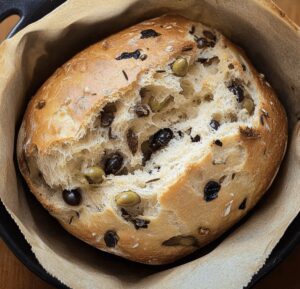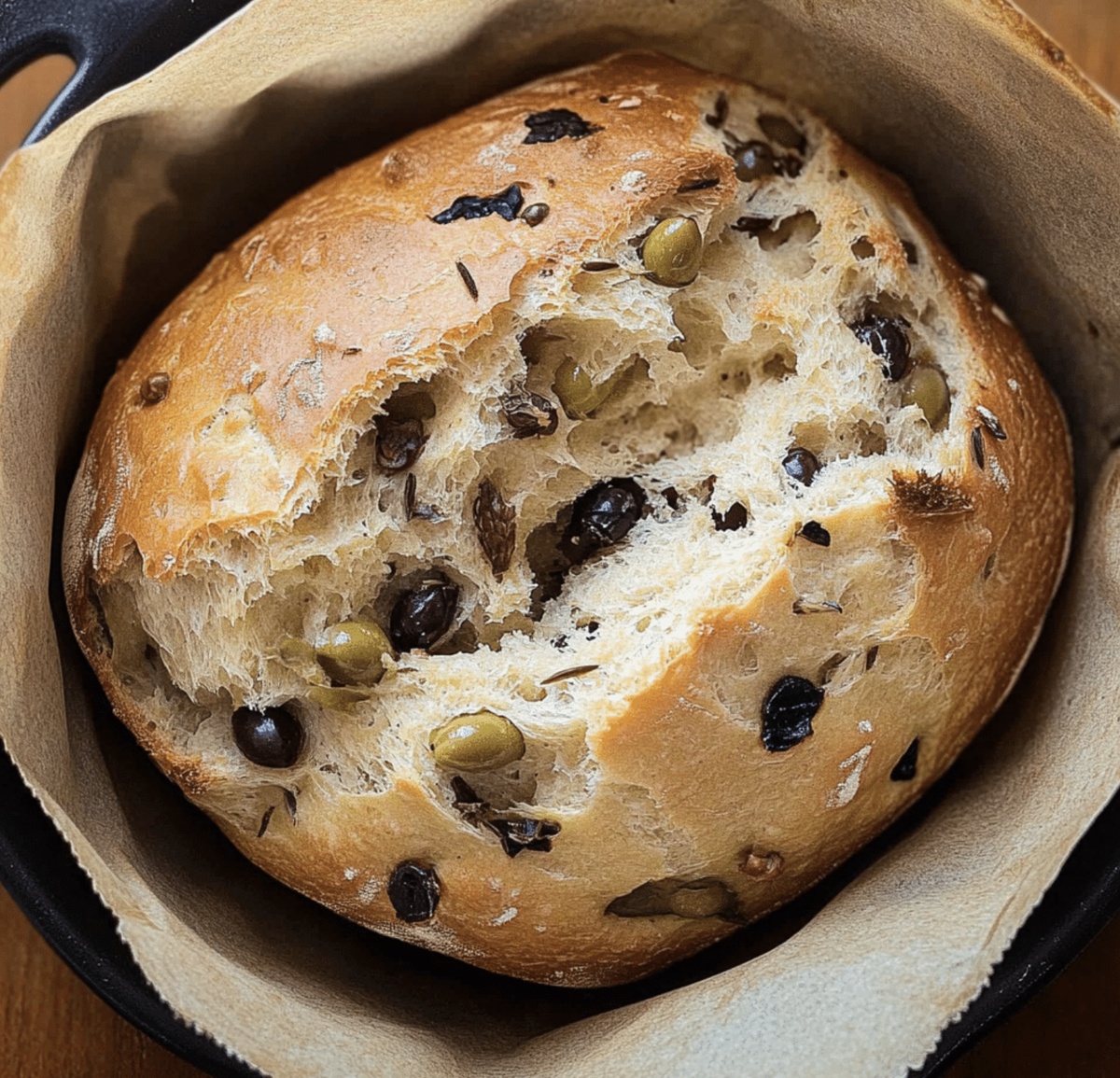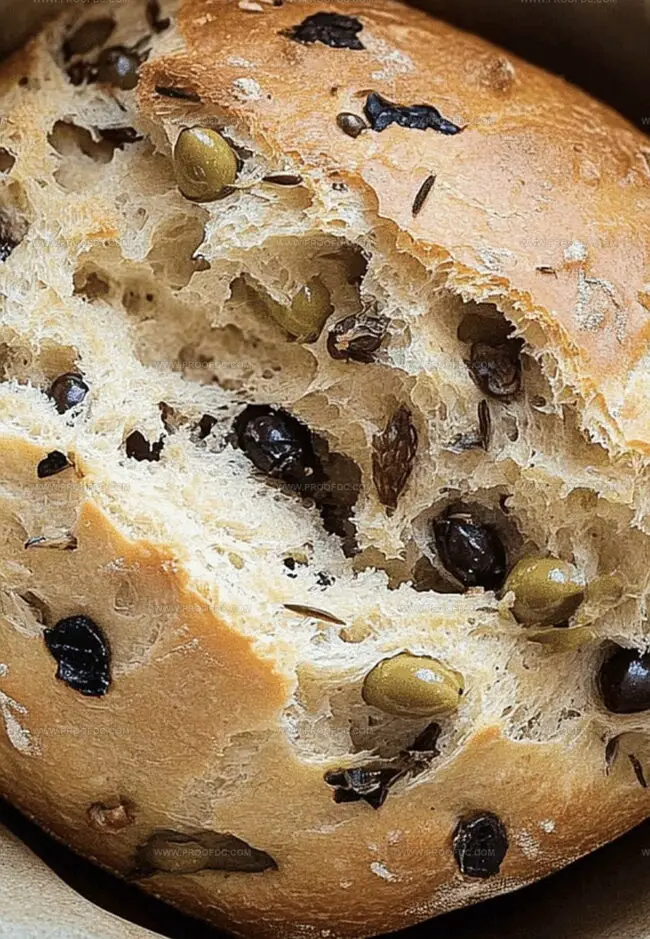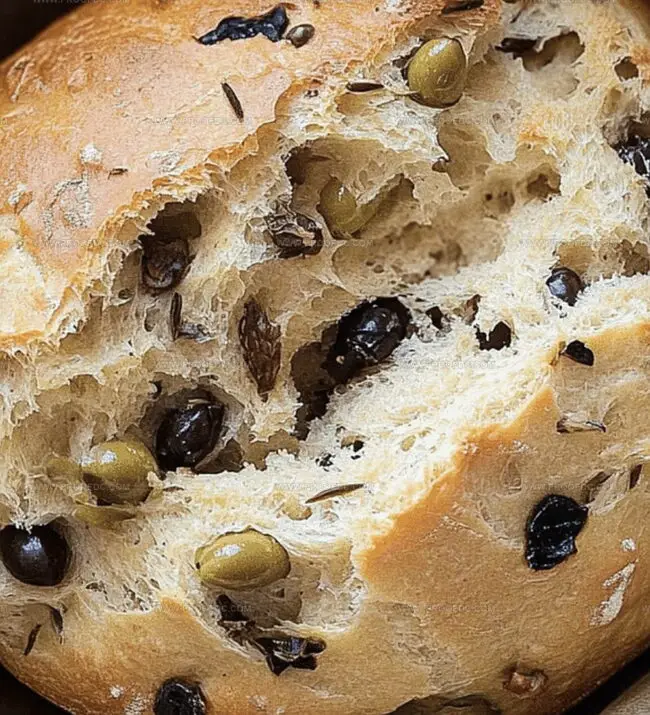Rustic Herb-Infused Olive Bread Recipe: A Tasty Homemade Delight
Warm, crusty olive bread with briny Mediterranean olives brings comfort to any table.
Bread lovers savor each delectable slice packed with robust flavors.
Olives scattered throughout the dough create a rustic, artisanal texture that delights the senses.
The aroma of freshly baked bread fills the kitchen with warmth and anticipation.
Simple ingredients combine to create a masterpiece that transports you to sun-drenched coastal regions.
Salt-kissed olives provide a delightful punch of flavor in every bite.
Each slice promises a culinary journey worth experiencing.
Dive into this Mediterranean-inspired bread that transforms an ordinary meal into something extraordinary.
Quick Recipe Overview
All The Ingredients In Olive Bread
For Activating The Yeast:For Forming The Bread Base:For Flavor Boosters:Kitchen Gear For Baking Olive Bread
Directions To Bake Olive Bread From Scratch
Warm water and yeast dance together, creating a bubbly potion that signals the start of bread transformation.
Flour and salt welcome the yeast mixture and olive oil, creating a sticky, promising dough that hints at deliciousness.
Chopped olives, rosemary, and oregano weave into the dough, giving it character and depth through gentle kneading until smooth and supple.
The dough nestles in a cozy, greased bowl, stretching and growing in a warm corner of the kitchen for about two hours.
Gently deflate the risen dough, molding it into a beautiful round or oval shape that promises rustic charm.
Let the shaped dough relax and puff up while the oven heats to a perfect golden-brown temperature.
The bread turns from pale dough to a gorgeous, crusty marvel with a golden exterior that beckons hungry souls.
Allow the bread to rest and cool, releasing its tantalizing aroma before slicing into its soft, olive-studded interior.
Customize The Flavor Of Olive Bread Your Way
How To Cut And Serve Olive Bread Right
Store Olive Bread To Keep It Soft And Tasty
Print
Rustic Olive Bread Recipe
- Total Time: 2 hours 55 minutes
- Yield: 11 1x
Description
Mediterranean olive bread showcases the rich, rustic flavors of Greece with a crisp crust and tender crumb. Savory herbs and briny olives create a delightful loaf you’ll crave alongside soups, salads, or as a standalone treat.
Ingredients
- 3.5 cups (440 g) all-purpose flour
- 1.5 cups (360 ml) warm water (110°F/43°C)
- 1 cup (150 g) pitted olives, chopped (black, green, or a mix)
- 1 packet (2.25 tsps) active dry yeast
- 2 tbsps olive oil
- 2 tsps salt
- 1 tsp sugar
- 1 tsp dried rosemary (or 1 tbsp fresh, chopped)
- 1 tsp dried oregano
Instructions
- Yeast Activation: Whisk yeast with warm water and sugar in a small bowl. Let the mixture foam and become bubbly for 7-9 minutes.
- Dough Foundation: Mix flour and salt in a large mixing bowl. Pour in activated yeast and olive oil, stirring until a sticky dough forms. Incorporate chopped olives, rosemary, and oregano.
- Kneading Process: Transfer dough to a floured surface and knead vigorously for 10-12 minutes, developing a smooth and elastic texture. The dough should become supple and responsive.
- First Proofing: Place dough in a lightly oiled ceramic bowl, cover with a clean kitchen towel. Rest in a warm, draft-free location for 90 minutes, allowing significant volume expansion and flavor development.
- Shaping and Second Proofing: Punch down the risen dough and shape into a rustic round or oval. Position on a parchment-lined baking sheet. Allow a secondary fermentation for 40-50 minutes while preheating the oven to 400°F.
- Baking Performance: Transfer loaf to preheated oven and bake for 35-40 minutes. The bread is ready when it turns golden-brown and produces a hollow sound when tapped.
- Cooling and Serving: Remove bread from oven and place on a wire rack. Let it cool completely to allow internal temperature to stabilize before slicing and serving.
Notes
- Master Yeast Activation: Ensure water temperature is between 100-110°F to perfectly activate yeast without killing it; too hot or cold will compromise bread rising.
- Optimize Olive Distribution: Chop olives into uniform, small pieces to prevent large chunks disrupting bread’s texture and ensure even flavor throughout the loaf.
- Control Kneading Technique: Use consistent, firm motions when kneading to develop strong gluten network; under-kneading results in dense bread, while over-kneading makes it tough.
- Manage Proofing Environment: Place dough in warm, draft-free area around 75-80°F for ideal rising; cover with damp cloth to prevent surface from drying and cracking during fermentation.
- Prep Time: 20 minutes
- Cook Time: 35 minutes
- Category: Snacks, Appetizer, Lunch
- Method: Baking
- Cuisine: Mediterranean
Nutrition
- Serving Size: 11
- Calories: 160
- Sugar: 0.5 g
- Sodium: 190 mg
- Fat: 4.5 g
- Saturated Fat: 0.5 g
- Unsaturated Fat: 4 g
- Trans Fat: 0 g
- Carbohydrates: 28 g
- Fiber: 1 g
- Protein: 4 g
- Cholesterol: 0 mg




Marcus Foley
Food Critic & Kitchen Coach
Expertise
Recipe Testing and Troubleshooting; Time-Saving Kitchen Hacks; Global Flavor Exploration; Engaging Food Writing and Honest Reviews.
Education
Institute of Culinary Education (ICE), New York, NY
Marcus Foley, based in Atlanta, GA, is a friendly food expert who makes cooking fun and simple.
With hands-on training from the Institute of Culinary Education and years of tasting everything from street food to fine dining, he shares easy kitchen hacks, global flavor ideas, and step-by-step recipes that turn kitchen mishaps into delicious surprises.